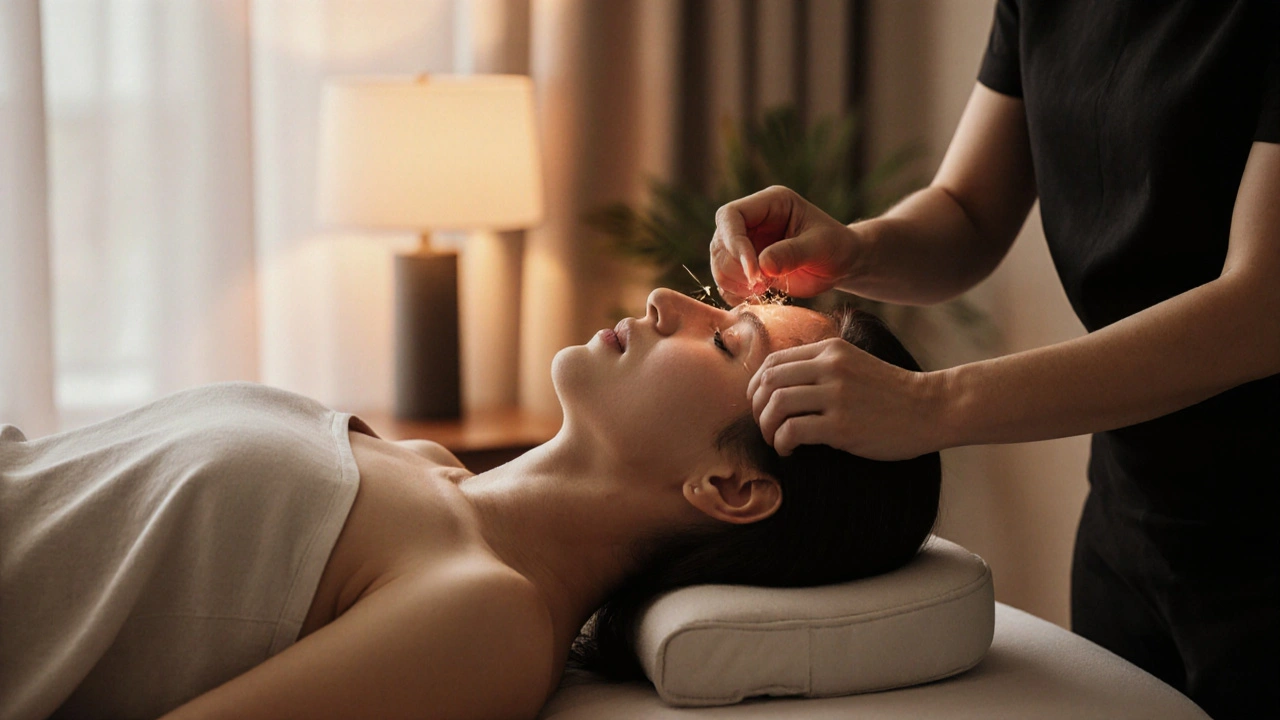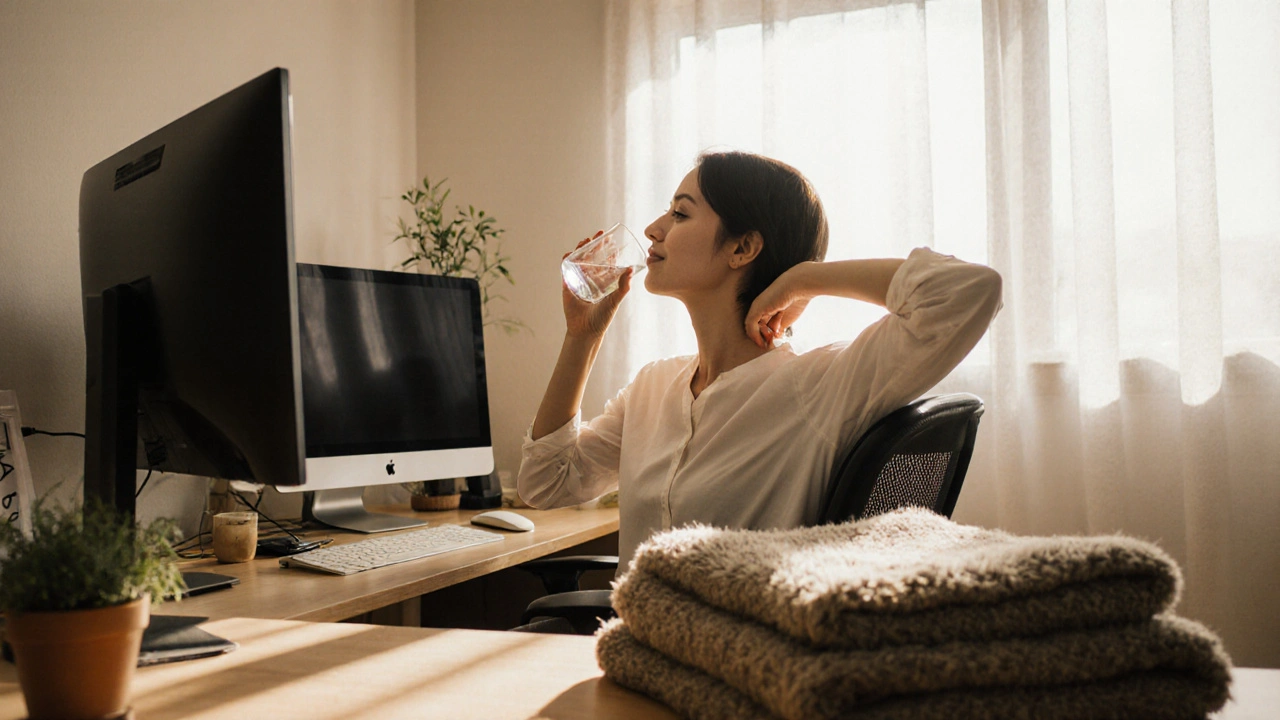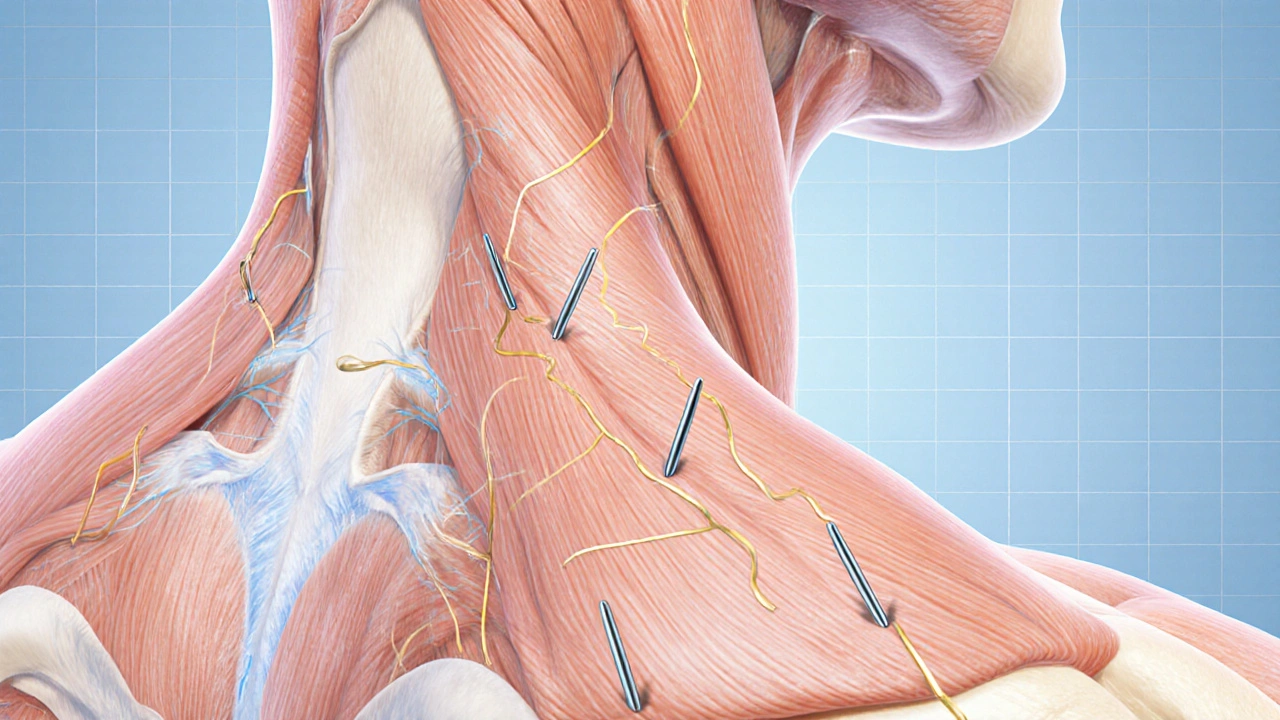Acupuncture Pain Reduction Estimator
Expected Pain Level After Treatment
Your estimated pain level:
Based on clinical studies showing 3.2-point average reduction on 10-point scale.
Individual results may vary.
Key Takeaways
- Acupuncture stimulates specific points to ease muscle tension and improve blood flow.
- Clinical trials show 60‑70% of participants experience reduced spasm intensity.
- Side‑effects are usually mild-brief soreness or tiny bruises.
- Choosing a registered practitioner is essential for safety.
- Acupuncture can complement stretching, hydration and ergonomic adjustments.
Understanding Acupuncture
When it comes to pain relief, acupuncture is a needle‑based therapy rooted in Traditional Chinese Medicine that stimulates specific points on the body to restore balance. Practitioners insert ultra‑thin stainless‑steel needles at predefined locations called acupoints. These points sit along pathways known as meridians, which, according to TCM, conduct vital energy or qi.
What Are Muscle Spasms?
Muscle spasm is an involuntary, sudden contraction of a muscle or a group of muscles that causes pain, stiffness, and limited movement. Common triggers include overuse, dehydration, electrolyte imbalance, nerve irritation, or prolonged static posture. When a fiber fires repeatedly, it creates a painful knot-often called a trigger point-that can radiate pain to neighboring areas.

How Acupuncture Helps Muscle Spasms
Scientific research points to several ways needles can calm a twitching muscle:
- Endogenous opioid release: Needle stimulation prompts the brain to secrete endorphins and enkephalins, natural painkillers that dampen nociceptive signals.
- Improved microcirculation: Local blood flow rises 20‑30% within minutes, delivering oxygen and clearing metabolic waste that sustains cramping.
- Neuromodulation: Needles affect A‑delta and C‑fiber activity, resetting abnormal firing patterns that cause spasms.
- Muscle relaxation via connective tissue: The mechanical lift of the needle loosens fascia, reducing the pull on trigger points.
- Regulation of inflammatory mediators: Studies show decreased levels of substance P and cytokines after a treatment series.
These mechanisms work together, providing both immediate relief and longer‑term re‑education of the nervous system.
Evidence From Clinical Research
A 2022 randomized controlled trial conducted at the University of Manchester enrolled 124 adults with chronic neck‑related spasms. Participants received twelve weekly acupuncture sessions or sham needle treatment. The acupuncture group reported a mean reduction of 3.2 points on a 10‑point pain scale, compared with 1.1 points for the sham group (p<0.001). Moreover, 68% of treated patients achieved at least a 50% improvement in spasm frequency.
Another systematic review of 15 trials (total n=1,342) found that acupuncture outperformed standard medication in both pain intensity and functional mobility, with an average risk ratio of 1.45 for achieving clinically significant relief.
While more high‑quality studies are needed, the current body of evidence suggests a meaningful benefit for many sufferers.
Safety, Side‑Effects, and Contraindications
Qualified acupuncturist is a practitioner who has completed accredited training, holds a registration with the British Acupuncture Council, and follows strict hygiene protocols. When treated by such a professional, serious complications are rare. The most common reactions are:
- Transient bruising at insertion sites.
- Brief soreness lasting a few hours.
- Light dizziness if the session triggers a vasovagal response.
Acupuncture should be avoided in the following situations:
- Bleeding disorders or anticoagulant therapy without medical clearance.
- Pregnancy (certain points are contraindicated in the first trimester).
- Local skin infections, eczema, or severe eczema over the treatment area.
Always disclose medications and health conditions during the intake interview.
What Happens During an Acupuncture Session
- Consultation: The practitioner reviews medical history, identifies key symptoms, and selects relevant acupoints.
- Needle insertion: Sterile, disposable needles (0.16‑0.25mm diameter) are gently tapped into the skin. In most cases the sensation is a faint tingling or heaviness.
- De‑qi sensation: A subtle dull ache or “electric” feeling indicates proper stimulation. The practitioner may slightly rotate or lift the needle to enhance this effect.
- Retention period: Needles remain for 20‑30minutes while the client relaxes on a treatment table.
- Removal: Needles are withdrawn with a smooth motion. The area is inspected for any bleeding and then covered with a sterile cotton pad.
- After‑care guidance: Clients receive advice on hydration, gentle stretching, and any activity modifications for the next 24‑48hours.
A typical course consists of 6‑12 weekly sessions, after which the practitioner reassesses progress and adjusts point selection.

Choosing the Right Practitioner
To maximise benefit and minimise risk, look for the following credentials:
- Registration with the British Acupuncture Council (BAcC) or the General Acupuncture Council (GAC).
- Completion of a Level 3 Diploma in Acupuncture (minimum 3years of study).
- Evidence of continuing professional development, especially in musculoskeletal disorders.
- Positive patient testimonials that mention muscle‑relaxation outcomes.
Don’t hesitate to ask about sterilisation procedures, needle disposal, and how the practitioner integrates acupuncture with other physiotherapy techniques.
Acupuncture vs. Other Treatments for Muscle Spasms
| Treatment | Typical Effectiveness | Side‑effects | Typical Cost (UK) |
|---|---|---|---|
| Acupuncture | 60‑70% report relief | Minor bruising, soreness | £45‑£70 per session |
| Physiotherapy | 55‑65% with targeted exercises | Rare, temporary soreness | £40‑£65 per session |
| NSAIDs (e.g., ibuprofen) | 30‑45% short‑term | Stomach upset, kidney risk | £4‑£10 per pack |
| Botox injections | 70‑80% in severe cases | Weakness, flu‑like symptoms | £250‑£350 per treatment |
Acupuncture stands out for its blend of moderate effectiveness, minimal systemic side‑effects, and a holistic approach that addresses underlying energy flow as well as physical tension.
Complementary Self‑Care Tips
Even with regular acupuncture, everyday habits play a big role in preventing spasms:
- Stay hydrated: Aim for at least 2liters of water daily; dehydration lowers the threshold for involuntary contractions.
- Electrolyte balance: Include potassium‑rich foods (bananas, sweet potatoes) and magnesium sources (nuts, leafy greens).
- Gentle stretching: Perform 5‑minute neck or back stretches after waking and before bed to keep muscle fibers lengthened.
- Ergonomic workspace: Adjust chair height, monitor level, and keyboard angle to avoid static load on the neck and shoulders.
- Heat therapy: A warm shower or heating pad for 10‑15 minutes can increase blood flow before an acupuncture session.
These steps reinforce the physiological changes induced by needles, making relief more lasting.
Frequently Asked Questions
Does acupuncture hurt?
Most people feel only a light tingling or a faint pressure when the needle is inserted. The sensation is usually far milder than a hypodermic injection, and many clients fall asleep during the 20‑minute retention period.
How many sessions will I need?
A typical course involves 6‑12 weekly visits. Some people notice improvement after just three sessions, while chronic cases may require a longer series followed by maintenance appointments every few months.
Can I combine acupuncture with medication?
Yes. Acupuncture often works well alongside prescribed muscle relaxants or anti‑inflammatory drugs, allowing you to lower dosages and reduce side‑effects. Always discuss any combination with your GP or pain specialist.
Is acupuncture covered by the NHS?
In limited cases, the NHS may fund acupuncture for chronic pain if a GP deems it appropriate. Most people pay privately, but many insurance plans offer partial reimbursement for complementary therapies.
What should I avoid after a session?
Avoid alcohol, heavy lifting, and hot baths for the first 24hours, as these can aggravate the delicate post‑needling tissue response. Light movement and gentle stretching are encouraged instead.

anshu vijaywergiya
October 12, 2025 AT 13:11Oh, the sheer elegance of needles dancing upon the meridian pathways! 🌟 Imagine a symphony where each tiny point sings to tight muscle fibers, coaxing them into graceful relaxation. I have witnessed countless patients who once felt shackled by relentless spasms, only to discover the gentle lullaby of acupuncture. It is not merely a treatment; it is an invitation to harmonize body and spirit. Let us all embrace this inclusive journey toward alleviation, for every twitching muscle deserves a chance at calm.
ADam Hargrave
October 13, 2025 AT 16:57Ah, the age‑old debate: prick a few points and hope the cosmos aligns. 🤔 One might argue that this practice is as philosophical as it is physiological-if you believe the universe is a grand tapestry of qi, then surely a few needles can rewrite its pattern. Yet, let’s not forget the patriotic pride in American innovation; we can modernize ancient art with rigorous trials. Still, the sarcasm creeps in when I see headlines hyping "miracle cures"-as if a needle could solve all our geopolitical woes. 😏
Rohit Poroli
October 14, 2025 AT 20:44From a biomedical perspective, the efficacy of acupuncture in mitigating musculoskeletal hyperexcitability hinges upon several neurophysiological mechanisms that have been elucidated through rigorous empirical inquiry. Firstly, needle insertion precipitates the release of endogenous opioids-endorphins, enkephalins, and dynorphins-that modulate nociceptive transmission at both spinal and supraspinal levels. Secondly, the localized microvascular response engenders a 20‑30% surge in perfusion, thereby enhancing oxygen delivery and facilitating the clearance of metabolic by‑products such as lactate and inflammatory mediators. Thirdly, mechanoreceptor activation influences the gating of A‑delta and C‑fiber afferents, effectively resetting aberrant firing patterns that underlie spasm genesis. Moreover, the mechanical lift imposed by the fine gauge stainless‑steel needle exerts a fascial decompression effect, attenuating the traction forces on trigger points and reducing secondary nociceptor sensitization. Additionally, longitudinal studies have documented a downregulation of pro‑inflammatory cytokines-substance P, interleukin‑1β, tumor necrosis factor‑α-post‑treatment, underscoring a systemic immunomodulatory impact. In terms of clinical outcomes, randomized controlled trials have reported mean reductions of 3.2 points on a 10‑point visual analog scale, surpassing sham controls by a statistically significant margin (p < 0.01). Importantly, the therapeutic window appears to broaden when acupuncture is integrated with adjunctive modalities such as progressive stretching, electrolyte repletion, and ergonomic optimization, thereby fostering a multimodal rehabilitation paradigm. Patient adherence, however, remains contingent upon practitioner credentialing, as the procedural fidelity and sterility standards are paramount for mitigating adverse events, which are typically limited to transient erythema and minor hematoma. Future research trajectories should prioritize high‑resolution functional imaging to delineate circuit‑level alterations in thalamocortical networks post‑needling, as well as genotype‑phenotype correlations that may predict individual responsiveness. In sum, acupuncture constitutes a biologically plausible, evidence‑supported intervention that can attenuate muscle spasm severity, augment functional recovery, and reduce reliance on pharmacologic analgesics.
Jessica Tang
October 16, 2025 AT 00:31Acupuncture can indeed be a valuable adjunct for muscle spasm relief. In practice, the practitioner first assesses the specific trigger points and selects corresponding acupoints to target. Gentle needle insertion is performed with minimal discomfort, and patients often report a warm or tingling sensation. Sessions typically last 20‑30 minutes, and a series of treatments yields the best results. Be sure to stay hydrated and follow post‑session guidelines to maximize benefits.
Matt Quirie
October 17, 2025 AT 04:17Interesting approach...........................................
Pat Davis
October 18, 2025 AT 08:04From a cultural standpoint, incorporating acupuncture into mainstream healthcare reflects an assertive respect for traditional practices while upholding rigorous safety standards. It is imperative that practitioners possess proper licensure and adhere to sterile techniques. Such integration not only broadens therapeutic options but also honors the heritage from which this modality originates.
Mary Wrobel
October 19, 2025 AT 11:51Ever thought of acupuncture as the brush that paints relief across a canvas of tight muscles? It’s like turning a stubborn knot into a smooth ribbon, all thanks to those tiny, precise needles. The science behind it maybe feels like magic, but it’s grounded in real physiological changes-blood flow, endorphins, you name it. Give it a try and let your body write its own story of ease!
Lauren Ulm
October 20, 2025 AT 15:37Okay, so they say these needles can calm your muscles, but have you ever considered that the whole thing might be a distraction from the bigger picture? 🤔🌐 The elite don’t want you to be comfortable; they want you focused on their agenda. Yet, a little acupuncture session could be the perfect cover for a subtle mind‑reset. Just saying! 😜
Michael Mendelson
October 21, 2025 AT 19:24Well, if you're looking for a fancy way to poke yourself and hope pain goes away, acupuncture's the perfect pseudo‑science. It's like paying for a placebo with needles. Good luck with that, buddy.
Patricia Fallbeck
October 22, 2025 AT 23:11Sure, acupuncture works-if you believe in the ancient art of needle‑worship! 😂 But let’s not forget: every study praising it is probably funded by a secret society of chiropractors. 🤷♀️ Still, I guess a little prick could be better than endless ibuprofen. 🎭
Brett Snyder
October 24, 2025 AT 02:57Only Americans would try to replace a good old workout with needle‑poking. Real strength comes from hard work, not from some foreign mystic practice. If you want results, lift something heavy instead of sitting in a dim room.
Nidhi Jaiswal
October 25, 2025 AT 06:44Acupuncture can help muscle spasms but you must stay hydrated and warm after session
Sunil Sharma
October 26, 2025 AT 10:31Let’s remember that acupuncture isn’t a miracle cure, but it can be a useful tool when combined with proper stretching and good posture. Stay open‑minded and consult a certified practitioner before starting.